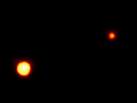The Status of Pluto

As an astronomy buff, I've been listening quietly to the talk of Pluto's planetary status for years. I never really paid it any attention. That is, until I saw Dr. Tyson from the Rose Center on the Colbert Report. Colbert has garnered clout, somehow. It's actually quite funny. Colbert's show started out as a satire, modeled after the 'O'Reilly Factor'. His ability to ask hard questions in an amusing manner has gained him a following. I watch regularly.
Anyway, Pluto, in the traditional sense, has always been, and will always be, a planet. So is Ceres and Xena. Any dot of light that moves in the sky is a 'planet'. That's the historical definition. The main planets have always been Mercury, Venus, Mars, Jupiter and Saturn. Later additions to the main planets, in no particular order, were Uranus, Neptune, Pluto and Earth (once we figured out we were on a planet). Taking it out of the list of main planets is retarded, and not really a step in the right direction.
We have classifications for planets, already. We are on Earth, which is an inner planet. The outer planets are both gas giants and Kuiper belt objects. Pluto is the only Kuiper belt object considered a main planet. Then, there are the minor planets, located primarily in the asteroid belt between Mars and Jupiter. There are nomenclature for them, as well, but none of these are what we've ever thought of as main planets (some of them are even classified as Plutinos!). To put it in perspective, there are 134,339 known minor planets.
So what makes Pluto so special? It's the historical significance of the planet. We've never cared about Ceres, because there's no real significance. First of all, it was discovered a full 129 years before Pluto, and wasn't considered a planet even back then. Secondly, it's a hunk of rock. If we decided that it was part of a large planet between Mars and Jupiter that broke up, we might give it more priority, and make it a textbook-worthy planet. But I don't recall any experimentation done to test that hypothesis, so Ceres remains uncanonized.
Every other planet we've canonized has been unique. Jupiter is a gas giant with multiple colored rings, and a huge, never-ending storm. Saturn has massive, easily visible rings. Uranus has a funky orbit and rotation axis. Neptune is a giant blue planet, that we once assumed was covered with water. Mars is red, and is very close to Earth. Venus was once considered our sister planet. Mercury, the closest to the sun of the 2 inferior planets, is famous for moving so quickly across the sky. Pluto is the first icy planet we really looked at. Everything else like it is a Pluto Class planet. Changing it's status now is a bad move, or at least a goofy one. Seems like the IAU is buckling to pressure, or something.










<< Home